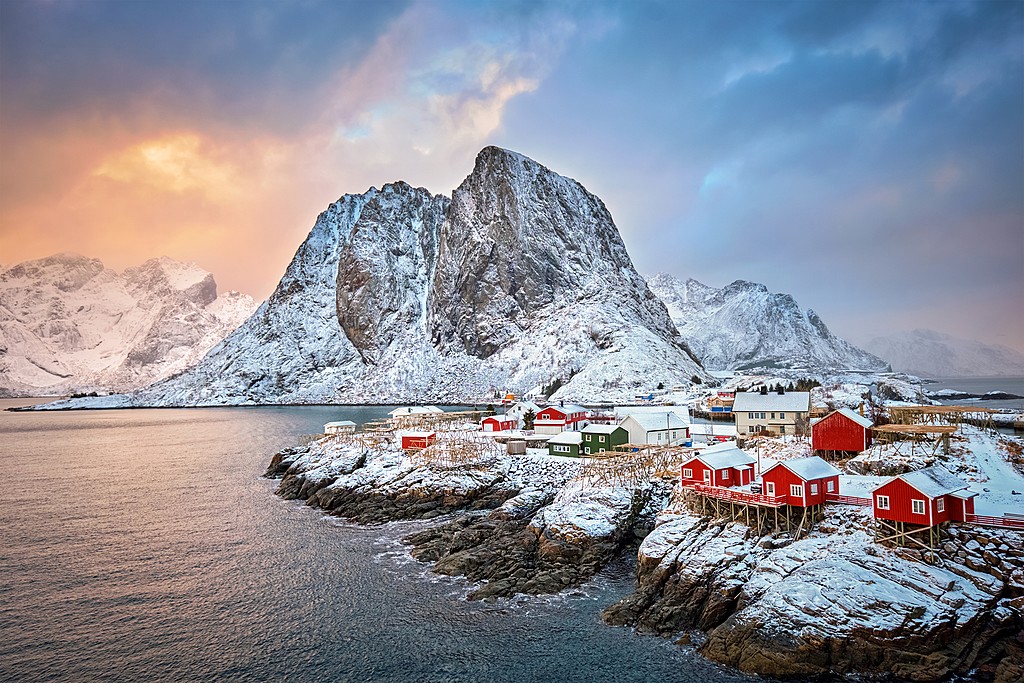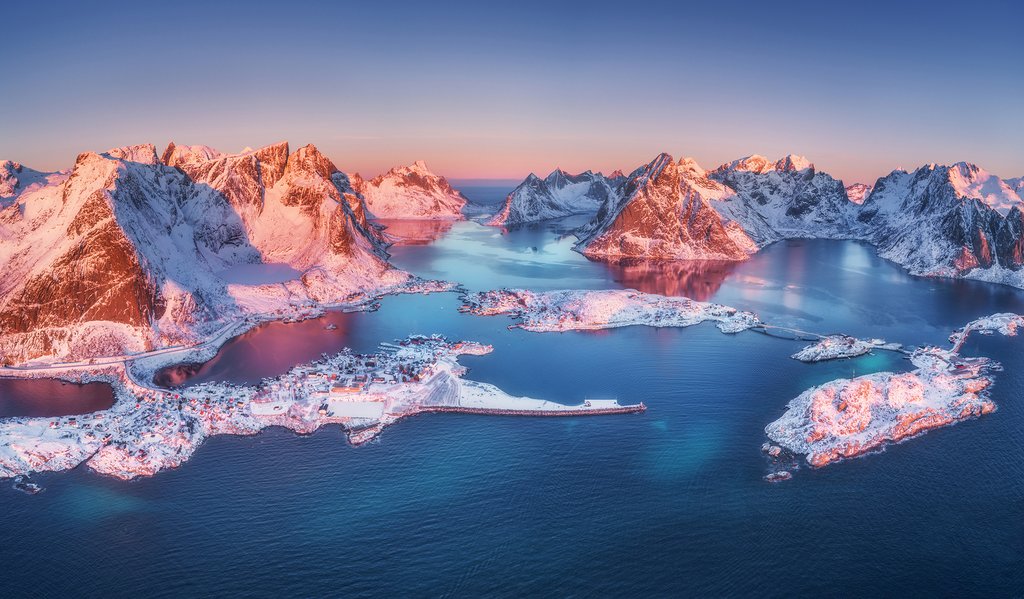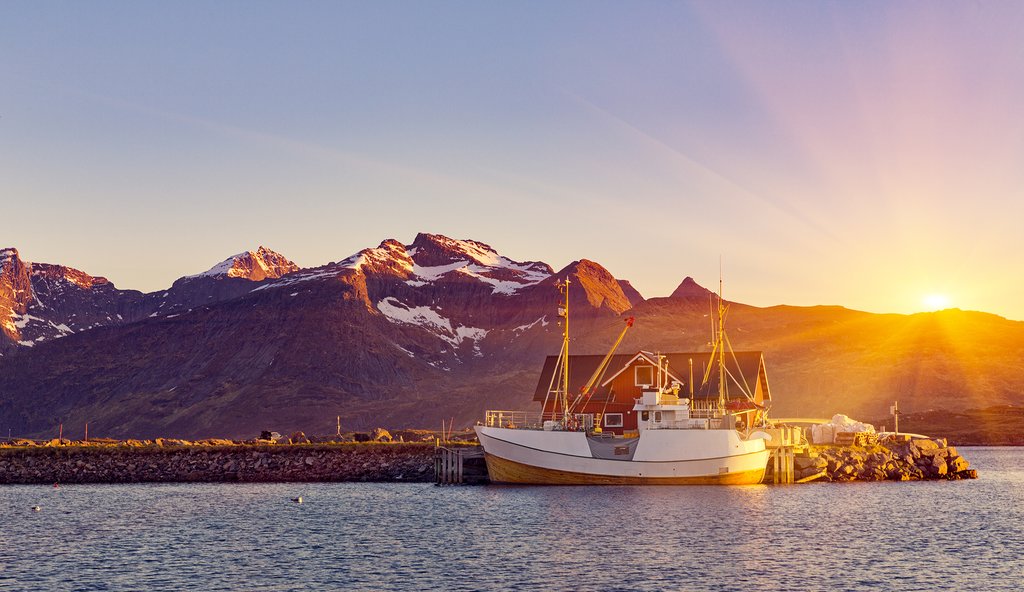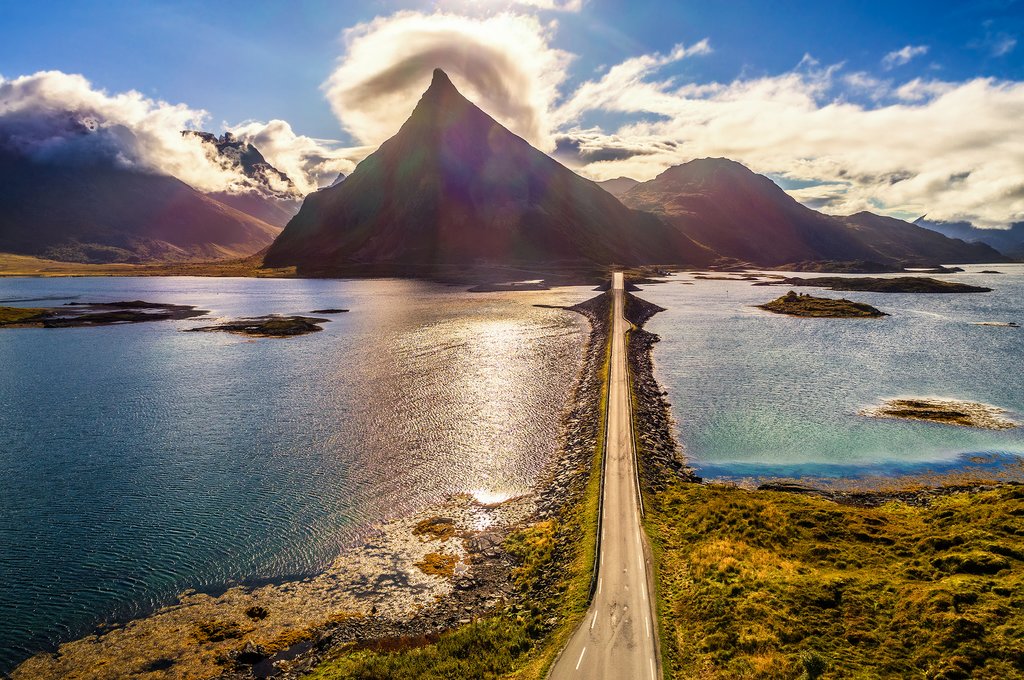
The word is out on the Lofoten Islands, especially in summer. Traveling in the off-season is an ideal option to bypass the crowds—and luckily, it’s easy to go at any time of year. Here’s what you can expect to find September through May.
## Exploring the Lofoten Islands Beyond the Summer Rush

The allure of the Lofoten Islands is undeniable. Those dramatic peaks rising from the turquoise waters, the charming red fishing cabins clinging to the shores, the endless vistas of unspoiled natural beauty – it’s a landscape that captures the imagination. However, this popularity has a downside: during the summer months, the Lofoten Islands transform into a bustling hub of tourist activity. Imagine arriving at Kvalvika Beach, eager to experience its pristine sands, only to find the parking lot completely overflowing, a clear indication of the crowds that await. Picture hotels booked solid months in advance, making it nearly impossible to secure accommodation. Consider ferries operating at maximum capacity, leaving travelers stranded and disappointed. In fact, recent years have seen these stunning islands welcome over a million visitors during the peak season, a testament to their appeal, but also a sign of the potential congestion.
Choosing to visit outside of the peak summer months might initially appear to be a compromise. The thought of packing warmer clothing, trading sandals for sweaters, and preparing for potentially unpredictable weather might seem like a sacrifice. After all, sweaters tend to occupy a significant amount of space in luggage! However, the reality is that an off-season visit can be a far more rewarding and enriching experience than battling the summer hordes. The roads remain open and accessible, allowing for easy exploration of the islands’ diverse landscapes. A significant number of businesses continue to operate, catering to the needs of visitors. And the hillsides, far from being barren, burst forth with the vibrant colors of each passing season, offering a spectacle all their own. The specific experiences you can anticipate will largely depend on the particular time of year you choose to visit, so let’s delve into the possibilities that await in spring, autumn, and winter.
## Lofoten in Spring, Autumn, and Winter: A Trio of Unique Experiences

**Spring** in the Lofoten Islands presents a unique, almost fleeting, spectacle. The “blooming season,” as many envision it, is relatively short-lived. April can often still be dominated by snow and lingering winter conditions. It’s really in May that the islands begin to awaken from their winter slumber, as nature reclaims the landscape with vibrant hues. The primary allure of a spring visit lies in the mesmerizing twilight nights, where the sun dips below the horizon for only a short period, casting a magical glow upon the landscape. The weather also begins to moderate, offering a welcome reprieve from the colder temperatures of winter. The islands prepare themselves for the arrival of summer, and a palpable sense of anticipation fills the air. While hiking in the mountains might still be challenging due to lingering snow cover, sticking to the coastal trails will allow you to explore the beauty of the islands.
**Autumn**, encompassing September and October, offers a truly captivating experience in the Lofoten Islands. It is a period characterized by volatile weather patterns, where rain is a frequent visitor. However, this unpredictable nature is precisely what makes autumn such a compelling time for photographers and nature enthusiasts. The hillsides erupt in a kaleidoscope of colors, as the foliage transforms into a fiery spectacle of reds, oranges, and yellows. The light throughout the day is constantly shifting, often punctuated by dramatic, ethereal glows that precede or follow a rain shower. Furthermore, autumn presents a fantastic opportunity to witness the awe-inspiring Northern Lights dancing across the night sky. If you possess a flexible itinerary and embrace the possibility of plans changing at a moment’s notice, autumn is a truly exceptional season to explore the Lofoten Islands.
**Winter** reigns supreme as the longest season in Lofoten, stretching from November all the way through March. The months of January to March arguably offer the quintessential “Lofoten in winter” aesthetic that many visitors seek. During this period, the landscape is draped in a pristine blanket of snow, creating a breathtaking contrast against the dark, jagged peaks. January and February are particularly interesting from a lighting perspective, as the sun takes several hours to make its slow “rise” and “set,” painting the sky with prolonged periods of twilight. As winter progresses, late in the season can be ideal for engaging in snow-based activities, such as skiing, as the weather tends to be more stable and predictable, and the sun gradually makes its presence known. Naturally, with fewer daylight hours, there are more opportunities to witness the spectacular display of the Northern Lights in all their magnificent glory.
## Unveiling the Activities: A Tapestry of Experiences
For those concerned about accessibility, rest assured that reaching the Lofoten Islands is relatively straightforward, regardless of the time of year. While the primary ferry service operates during the summer months, alternative transportation options, such as air travel and the Hurtigruten coastal express, remain available year-round. Once you arrive on the islands, renting a car is highly recommended. Although bus services exist, they are infrequent and often limit your ability to explore the more remote and captivating corners of the archipelago. Having your own transportation allows you to venture off the beaten path and discover hidden gems at your own pace.
In terms of activities, the Lofoten Islands possess an inherent beauty that endures throughout the year, presenting a wealth of opportunities for exploration and adventure. Even during the off-season, you will discover a multitude of experiences waiting to be enjoyed. Beyond the traditional summer pursuits, activities such as skiing, sailing, fishing, and surfing offer a unique perspective on the islands’ natural wonders. Unstad, renowned for its powerful waves, is considered one of the premier surfing destinations in Europe. The cod fishing season around March is a spectacle in itself, drawing anglers from far and wide. Consider combining different activities for a truly unforgettable experience, such as embarking on a ski and sail tour. Trollfjord and sea eagle safaris continue to operate throughout the winter months, providing thrilling encounters with the local wildlife.
Of course, the mainstays of hiking and Northern Lights viewing are always present. While hiking might be less accessible during spring and winter due to snow cover, these periods offer excellent opportunities for snowshoeing. The Northern Lights tend to be most vibrant around the New Year, but sightings are possible throughout the off-season. The unique light conditions during the winter and spring months, known as “blue hours,” offer a captivating spectacle, where the landscape is bathed in a soft, ethereal glow.
If photography is your passion, visiting during the off-season will undoubtedly enhance your creative pursuits. With fewer crowds to navigate, you’ll have greater freedom to capture the stunning landscapes and unique moments that the Lofoten Islands have to offer.
## Embarking on a Road Trip: A Journey Through the Islands

Embarking on a road trip from Svolvaer to Å is an unforgettable experience, arguably even more rewarding when the crowds are thinner and the weather is refreshingly crisp. The ability to explore the outdoors at your leisure, then retreat to the warmth and comfort of your car, adds an element of flexibility and enjoyment.
One of your first stops along the route should be Henningsvaer, a picturesque fishing village located approximately 30 minutes from Svolvaer. Henningsvaer boasts an authentic charm that sets it apart from the more tourist-oriented Svolvaer. Situated just off the E10 highway, the detour to this delightful village is well worth the effort, even if it were the sole destination. Upon arrival, consider arranging a delectable seafood dinner and engaging in conversation with a local fisherman, gaining insights into the town’s rich maritime heritage.
The Lofotr Viking Museum, nestled in Borg, offers a fascinating glimpse into the region’s Viking past. However, it’s essential to note the museum’s limited off-season operating hours, typically 12-3pm two days a week. Despite the restricted schedule, a visit to the museum is highly recommended. After immersing yourself in Viking history, venture to Unstad, a renowned surfing hotspot. Even in temperatures as low as 30°F, you’re likely to witness a handful of dedicated surfers riding some of Europe’s finest waves, with some claiming that the surfing conditions are even better during the winter months. The area surrounding Unstad is exceptionally beautiful, even by Lofoten standards, so be sure to dedicate ample time to capturing its breathtaking scenery with your camera.
Nusfjord and Ramberg are two additional villages that are undeniably stunning. Be sure to stop at the beach near Ramberg, conveniently located off the E10 highway. As you continue your journey, the scenery becomes even more captivating. You’re approaching Hamnoy and Reine, two of the most iconic villages in the Lofoten Islands, widely recognized for their picturesque charm. Here, you’ll encounter the famous red fishing cabins (rorbuer), and if you’re seeking accommodation in one of these traditional dwellings, Hamnoy is an excellent choice.
From Hamnoy and Reine, you’re nearing the end of the line at Å. This charming village is home to the Lofoten Stockfish Museum and the Norwegian Fishing Village Museum, both offering insights into the region’s rich maritime heritage. However, it’s advisable to check the museums’ reduced off-season operating hours. A year-round ferry service operates from nearby Moskenes to Bodø, providing connections to other destinations. Numerous smaller fishing villages dot the surrounding area, each with its own unique character. When you’re ready to return, consider retracing your steps and experiencing the route from a fresh perspective.
B-1949
